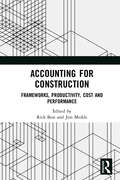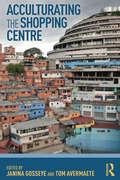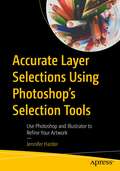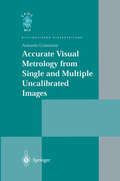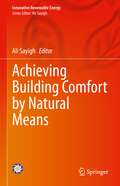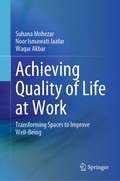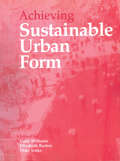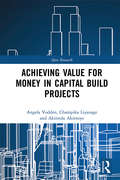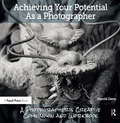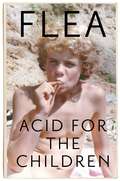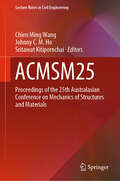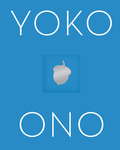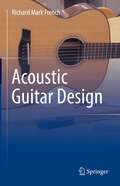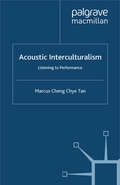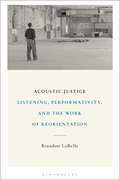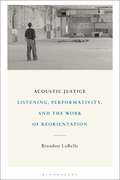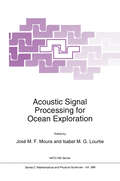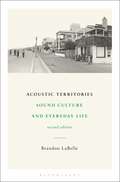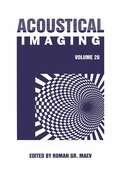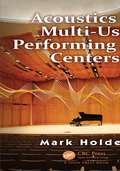- Table View
- List View
Accounting for Construction: Frameworks, Productivity, Cost and Performance
by Rick Best Jim MeikleAccounting for Construction follows on from Measuring Construction, edited by the same team. It extends the coverage of some of the material in the first volume and expands the range of related topics to include, inter alia, shadow economies, accounting for informal construction and the treatment of the built environment sector in national accounts. Taken together, the two volumes collate a range of topics that are only addressed, if addressed at all, in occasional academic papers and the publications of bodies such as national statistical offices and the World Bank. Accounting for Construction presents international examples from the UK, Australia and New Zealand and from both academic and professional contributors. This book is essential reading for all researchers and professionals interested in construction economics, construction management, and anyone interested in how the construction industry affects the global economy in ways previously under-represented in the literature.
Acculturating the Shopping Centre
by Janina Gosseye Tom AvermaeteAcculturating the Shopping Centre examines whether the shopping centre should be qualified as a global architectural type that effortlessly moves across national and cultural borders in the slipstream of neo-liberal globalization, or should instead be understood as a geographically and temporally bound expression of negotiations between mall developers (representatives of a global logic of capitalist accumulation) on the one hand, and local actors (architects/governments/citizens) on the other. It explores how the shopping centre adapts to new cultural contexts, and questions whether this commercial type has the capacity to disrupt or even amend the conditions that it encounters. Including more than 50 illustrations, this book considers the evolving architecture of shopping centres. It would be beneficial to academics and students across a number of areas such as architecture, urban design, cultural geography and sociology.
Acculturating the Shopping Centre
by Janina Gosseye Tom AvermaeteAcculturating the Shopping Centre examines whether the shopping centre should be qualified as a global architectural type that effortlessly moves across national and cultural borders in the slipstream of neo-liberal globalization, or should instead be understood as a geographically and temporally bound expression of negotiations between mall developers (representatives of a global logic of capitalist accumulation) on the one hand, and local actors (architects/governments/citizens) on the other. It explores how the shopping centre adapts to new cultural contexts, and questions whether this commercial type has the capacity to disrupt or even amend the conditions that it encounters. Including more than 50 illustrations, this book considers the evolving architecture of shopping centres. It would be beneficial to academics and students across a number of areas such as architecture, urban design, cultural geography and sociology.
Accurate Layer Selections Using Photoshop’s Selection Tools: Use Photoshop and Illustrator to Refine Your Artwork
by Jennifer HarderTake your hand-drawn illustrations to the next level by using various selection tools in Photoshop to clean up the artwork, and Illustrator for final refinement. Also, learn to save your artwork as vector images to be used for web, print, or even stills for character animation. Author Jennifer Harder begins by showing you how to use basic tools in Photoshop to clean up your artwork, followed by Marquee tools and more. Next, you will see how to use more advanced tools such as Lasso, Magic Wand, the Object Selection tool, and so on. You’ll then get a demonstration of how to control the type of selection using the selection main menu, how to copy selections to another layer, and how to use the focus area. This is followed by a chapter that covers paths, channels, and layer masks that you will master to clean up your artwork. To round things out, you will learn how to use Illustrator’s different features to further enhance your work. On completing the book, you will have mastered how to make your artwork and illustrations portfolio-ready. What You Will LearnMaster each selection tool found in PhotoshopChoose the right tools for cleaning and refining artworkSave selections for other projectsMake your artwork scalable in Illustrator using various methods Who Is This Book For Readers with little-to-intermediate-level experience with Photoshop.
Accurate Visual Metrology from Single and Multiple Uncalibrated Images (Distinguished Dissertations)
by Antonio CriminisiAccurate Visual Metrology from Single and Multiple Uncalibrated Images presents novel techniques for constructing three-dimensional models from bi-dimensional images using virtual reality tools. Antonio Criminisi develops the mathematical theory of computing world measurements from single images, and builds up a hierarchy of novel, flexible techniques to make measurements and reconstruct three-dimensional scenes from uncalibrated images, paying particular attention to the accuracy of the reconstruction.This book includes examples of interesting viable applications (eg. Forensic Science, History of Art, Virtual Reality, Architectural and indoor measurements), presented in a simple way, accompanied by pictures, diagrams and plenty of worked examples to help the reader understand and implement the algorithms.
Achieving Building Comfort by Natural Means (Innovative Renewable Energy)
by Ali SayighAchieving Building Comfort by Natural Means explores examples of green building designs and methods that are currently being used around the world to achieve human comfort in buildings. The operation of buildings accounts for more than 40% of total energy use and is a major source of carbon emissions. It is imperative that this consumption be substantially decreased and that energy needed for building comfort is obtained from renewable and environmentally friendly sources. This book brings together a global group of contributors who look at factors such as location, climate, building materials, energy management, ventilation, thermal environmental conditions, shading, lighting, acoustics, and more that are critical for achieving buildings that are more sustainable.Thermal comfort and climatic potential of ventilative cooling in Italian climates is available open access under a Creative Commons Attribution 4.0 International License via link.springer.com.
Achieving Quality of Life at Work: Transforming Spaces to Improve Well-Being
by Suhana Mohezar Noor Ismawati Jaafar Waqar AkbarThis book provides an understanding and imaging of how a stress-free workplace might be designed and implemented in the context of the ‘new normal.’ Statistics show that more and more people are experiencing an increase in work-related stress, and its impact on individual psychology and well-being as well as organizational performance can be devastating. Globally, the most recent data on work-related illnesses account for 2.4 million deaths. Against this backdrop, and taking stock of how the pandemic is affecting the workplace and employee well-being, this book proposes transformations in work spaces, from implementing effective “greening” features, to more efficient technology-supported spaces. It establishes links between workplace design and creativity, happiness and productivity, confronting related issues such as generation gaps, digital interruptions, collaborative work environments and sustainability, and their respective connections with workspace environment and well-being. The book situates this discussion within a broader discussion on work and quality of life. Furthermore, the book demonstrates how several sustainable development goals might be achieved through transformed work spaces. Through an intersection between organizational psychology, well-being and quality of life studies, sociology, human resources, and ergonomics, this book is a timely examination of work-related stress in relation to work spaces that require rethinking and transformation in the throes, and wake, of the pandemic.
Achieving Sustainable Urban Form
by Elizabeth Burton Mike Jenks Katie WilliamsAchieving Sustainable Urban Form represents a major advance in the sustainable development debate. It presents research which defines elements of sustainable urban form - density, size, configuration, detailed design and quality - from macro to micro scale. Case studies from Europe, the USA and Australia are used to illustrate good practice within the fields of planning, urban design and architecture.
Achieving Sustainable Urban Form
by Katie Williams Elizabeth Burton Mike JenksAchieving Sustainable Urban Form represents a major advance in the sustainable development debate. It presents research which defines elements of sustainable urban form - density, size, configuration, detailed design and quality - from macro to micro scale. Case studies from Europe, the USA and Australia are used to illustrate good practice within the fields of planning, urban design and architecture.
Achieving Value for Money in Capital Build Projects (Spon Research)
by Angela Vodden Champika Liyanage Akintola AkintoyeThis book is the first to bring together academic and practitioner views of Value for Money (VFM). VFM has been used to assess whether or not an organisation has obtained the maximum benefit within the resources available to it. A concept used by the public sector to assess the benefits of major built environment projects, it has become a major tenet of public private partnerships, capital project infrastructure and civil engineering megaprojects. This book presents and discusses the various debates surrounding the concept of Value for Money. It provides an international perspective on VFM by drawing upon the existing and fast developing body of principles and practices for Capital Build Projects. Readers will gain a level of understanding of the issues involved, the challenges, opportunities and the support mechanisms and protocols required for implementation of VFM in capital building development. Ultimately, the book presents a protocol that has been developed to track and monitor the VFM of a capital project from day 1, an Equilibrium Testing Mechanism (ETM) developed by the authors. This testing mechanism allows each of the parties to a project to monitor their VFM position at any given stage of a project from the beginning to the end of the build stage and beyond as necessary. This book is both a useful reference for researchers and a practical guide for the construction and engineering industry.
Achieving Value for Money in Capital Build Projects (Spon Research)
by Angela Vodden Champika Liyanage Akintola AkintoyeThis book is the first to bring together academic and practitioner views of Value for Money (VFM). VFM has been used to assess whether or not an organisation has obtained the maximum benefit within the resources available to it. A concept used by the public sector to assess the benefits of major built environment projects, it has become a major tenet of public private partnerships, capital project infrastructure and civil engineering megaprojects. This book presents and discusses the various debates surrounding the concept of Value for Money. It provides an international perspective on VFM by drawing upon the existing and fast developing body of principles and practices for Capital Build Projects. Readers will gain a level of understanding of the issues involved, the challenges, opportunities and the support mechanisms and protocols required for implementation of VFM in capital building development. Ultimately, the book presents a protocol that has been developed to track and monitor the VFM of a capital project from day 1, an Equilibrium Testing Mechanism (ETM) developed by the authors. This testing mechanism allows each of the parties to a project to monitor their VFM position at any given stage of a project from the beginning to the end of the build stage and beyond as necessary. This book is both a useful reference for researchers and a practical guide for the construction and engineering industry.
Achieving Your Potential As A Photographer: A Creative Companion and Workbook
by Harold DavisComing from the perspective that true inspiration and great image making are at the core of any high-level photographic endeavour, Achieving Your Potential as a Digital Photographer presents an organized and cohesive plan for kickstarting creativity, and then taking the resulting work into the real world. The ideas presented have been formulated by Harold Davis over many years working as a creative artist and award-wining photographer, and in the celebrated workshops he has developed and led all around the world. These concepts are presented with accompanying exercises so that readers can put them into everyday practice as well as workbook pages bound into the book for note taking and journaling. This book will enrich your photographic practice whether the goal is simply to enrich your photography or to make money from your work.
Achieving Your Potential As A Photographer: A Creative Companion and Workbook
by Harold DavisComing from the perspective that true inspiration and great image making are at the core of any high-level photographic endeavour, Achieving Your Potential as a Digital Photographer presents an organized and cohesive plan for kickstarting creativity, and then taking the resulting work into the real world. The ideas presented have been formulated by Harold Davis over many years working as a creative artist and award-wining photographer, and in the celebrated workshops he has developed and led all around the world. These concepts are presented with accompanying exercises so that readers can put them into everyday practice as well as workbook pages bound into the book for note taking and journaling. This book will enrich your photographic practice whether the goal is simply to enrich your photography or to make money from your work.
Acid For The Children - The autobiography of Flea, the Red Hot Chili Peppers legend: A Memoir
by FleaFlea, the iconic bassist and co-founder, alongside Anthony Kiedis, of the immortal Red Hot Chili Peppers finally tells his fascinating origin story, complete with all the dizzying highs and the gutter lows you'd expect from an LA street rat turned world-famous rock star.Michael Peter Balzary was born in Melbourne, Australia, on October 16, 1962. His more famous stage name, Flea, and his wild ride as the renowned bass player for the Red Hot Chili Peppers was in a far and distant future. Little Michael from Oz moved with his very conservative, very normal family to Westchester, New York, where life as he knew it was soon turned upside down. His parents split up and he and his sister moved into the home of his mother's free-wheeling, jazz musician boyfriend - trading in rules, stability, and barbecues for bohemian values, wildness, and Sunday afternoon jazz parties where booze, weed, and music flowed in equal measure. There began Michael's life-long journey to channel all the frustration, loneliness, love, and joy he felt into incredible rhythm.When Michael's family moved to Los Angeles in 1972, his home situation was rockier than ever. He sought out a sense of belonging elsewhere, spending most of his days partying, playing basketball, and committing petty crimes. At Fairfax High School, he met another social outcast, Anthony Kiedis, who quickly became his soul brother, the yin to his yang, his partner in mischief. Michael joined some bands, fell in love with performing, and honed his skills. But it wasn't until the night when Anthony, excited after catching a Grandmaster Flash concert, suggested they start their own band that he is handed the magic key to the cosmic kingdom.Acid for the Children is as raw, entertaining and wildly unpredictable as its author. It's both a tenderly evocative coming of age story and a raucous love letter to the power of music and creativity.
ACMSM25: Proceedings of the 25th Australasian Conference on Mechanics of Structures and Materials (Lecture Notes in Civil Engineering #37)
by Chien Ming Wang Johnny C. M. Ho Sritawat KitipornchaiThis book presents articles from The Australasian Conference on the Mechanics of Structures and Materials (ACMSM25 held in Brisbane, December 2018), celebrating the 50th anniversary of the conference. First held in Sydney in 1967, it is one of the longest running conferences of its kind, taking place every 2–3 years in Australia or New Zealand. Bringing together international experts and leaders to disseminate recent research findings in the fields of structural mechanics, civil engineering and materials, it offers a forum for participants from around the world to review, discuss and present the latest developments in the broad discipline of mechanics and materials in civil engineering.
Acorn
by Yoko Ono"It's nearly 50 years ago that my book of conceptual instructions Grapefruit was first published. In these pages I'm picking up where I left off. After each day of sharing the instructions you should feel free to question, discuss, and/or report what your mind tells you. I'm just planting the seeds. Have fun." - Yoko OnoLegendary avant-garde icon Yoko Ono has inspired generations of artists and performers. In Acorn, she offers enchanting and thought-provoking exercises that open our eyes-and all of our senses - to more creative and mindful ways of relating to ourselves, each other, and the planet we cohabit. Throughout this beautifully designed book are 100 black-and-white line drawings by Yoko. Like this legendary woman herself, the book is wildly original, stimulating, and hard to label: call it purposeful play, call it brain poetry, call it guided motivation, call it Zen-like incantations, call it whatever you want. But read it. Acorn may change the way you experience the world.
Acoustic Guitar Design
by Richard Mark FrenchThis book is for experienced luthiers and guitar designers in the industry, novice builders wishing to improve their designs, and guitar owners interested in knowing more about their instruments. It includes the most important technical information gathered from many sources, including the academic literature and the author’s own work, presented here in a clear, actionable form with a minimum of mathematics. The book begins with a historical survey on how important features of the acoustic guitar evolved over centuries. The review leads up to a chapter focusing on three iconic instruments that represent the most important types of acoustic guitars: classical, steel string flat top and archtop. As the guitar market is so strongly conditioned by familiar, traditional instruments, a successful builder must have a thorough working understanding of the most important designs to underpin their own work. Through this volume, Professor French lays out the entire design process and collects detailed information in one convenient source. Luthiers quite often compile notebooks of measurements, part numbers, specific design features and other details they routinely need. This book organizes much of that information, with tables of dimensions, material properties, and other details in one essential final chapter. The book also features concise side bar contributions by top guitar designers and builders including Tim Shaw, Chief Engineer at Fender Music; Bob Taylor, Co-Founder of Taylor Guitars; and Andy Powers, Master Guitar Designer and Partner.
Acoustic Interculturalism: Listening to Performance (Studies in International Performance)
by Marcus Cheng TanAcoustic Interculturalism is a study of the soundscapes of intercultural performance through the examination of sound's performativity. Employing an interdisciplinary approach, the book examines an akoumenological reception of sound to postulate the need for an acoustic knowing – an awareness of how sound shapes the intercultural experience.
Acoustic Justice: Listening, Performativity, and the Work of Reorientation
by Brandon LaBelleAcoustic Justice engages issues of recognition and misrecognition by mobilizing an acoustic framework. From the vibrational intensities of common life to the rhythm of bodies in movement, and drawing from his ongoing work on sound and agency, Brandon LaBelle positions acoustics, and the broader experience of listening, as a dynamic means for fostering responsiveness, understanding, dispute, and the work of reorientation. As such, acoustic justice emerges as a compelling platform for engaging struggles over the right to speak and to be heard that extends toward a broader materialist and planetary view. This entails critically addressing questions of space, borders, community, and the acoustic norms defining capacities of listening, leading to what LaBelle terms “poetic ecologies of resonance.” Acoustic Justice works at issues of recognition and resistance, place and displacement, by moving across a range of pertinent references and topics, from social practices and sound art to the performativity of skin and the poetics of Deaf voice. Through such transversality, LaBelle pushes for acoustics as the basis for strategies of refusal and repair.
Acoustic Justice: Listening, Performativity, and the Work of Reorientation
by Brandon LaBelleAcoustic Justice engages issues of recognition and misrecognition by mobilizing an acoustic framework. From the vibrational intensities of common life to the rhythm of bodies in movement, and drawing from his ongoing work on sound and agency, Brandon LaBelle positions acoustics, and the broader experience of listening, as a dynamic means for fostering responsiveness, understanding, dispute, and the work of reorientation. As such, acoustic justice emerges as a compelling platform for engaging struggles over the right to speak and to be heard that extends toward a broader materialist and planetary view. This entails critically addressing questions of space, borders, community, and the acoustic norms defining capacities of listening, leading to what LaBelle terms “poetic ecologies of resonance.” Acoustic Justice works at issues of recognition and resistance, place and displacement, by moving across a range of pertinent references and topics, from social practices and sound art to the performativity of skin and the poetics of Deaf voice. Through such transversality, LaBelle pushes for acoustics as the basis for strategies of refusal and repair.
Acoustic Signal Processing for Ocean Exploration (Nato Science Series C: #388)
by J. M. F Moura Isabel M. G. LourtieAcoustic Signal Processing for Ocean Explortion has two major goals: (i) to present signal processing algorithms that take into account the models of acoustic propagation in the ocean and; (ii) to give a perspective of the broad set of techniques, problems, and applications arising in ocean exploration. The book discusses related issues and problems focused in model based acoustic signal processing methods. Besides addressing the problem of the propagation of acoustics in the ocean, it presents relevant acoustic signal processing methods like matched field processing, array processing, and localization and detection techniques. These more traditional contexts are herein enlarged to include imaging and mapping, and new signal representation models like time/frequency and wavelet transforms. Several applied aspects of these topics, such as the application of acoustics to fisheries, sea floor swath mapping by swath bathymetry and side scan sonar, autonomous underwater vehicles and communications in underwater are also considered.
Acoustic Territories, Second Edition: Sound Culture and Everyday Life
by Brandon LaBelleThe revised edition of Acoustic Territories: Sound Culture and Everyday Life offers an expansive reading of auditory life. It provides a careful consideration of the performative dynamics inherent to sounding and listening, and discusses how sound studies may illuminate understandings of contemporary society. Combining research on urbanism, popular culture, street life and sonic technologies, Acoustic Territories opens up a range of critical perspectives--it challenges debates surrounding noise pollution and charts an "acoustic politics of space" by engaging auditory experience as found within particular cultural histories and related ideologies. Brandon LaBelle traces sound culture through a topographic structure: from underground territories to the home, and further, into the rhythms and vibrations of streets and neighborhoods, and finally to the sky itself as an arena of transmitted imaginaries. The new edition includes an additional "global territory" of the relational, positioning acoustics as a range of everyday practices that rework dominant tonalities. Questions of orientation and emplacement are critically raised, reframing listening as multi-modal and intrinsic to resistant socialities and what the author terms "acts of compositioning." The book is fully updated to include new relevant research and references surfacing since 2010, as well as a new preface to the second edition. Acoustic Territories continues to uncover the embedded tensions and potentialities inherent to sound as it exists in the everyday spaces around us.
Acoustic Territories, Second Edition: Sound Culture and Everyday Life
by Brandon LaBelleThe revised edition of Acoustic Territories: Sound Culture and Everyday Life offers an expansive reading of auditory life. It provides a careful consideration of the performative dynamics inherent to sounding and listening, and discusses how sound studies may illuminate understandings of contemporary society. Combining research on urbanism, popular culture, street life and sonic technologies, Acoustic Territories opens up a range of critical perspectives--it challenges debates surrounding noise pollution and charts an "acoustic politics of space" by engaging auditory experience as found within particular cultural histories and related ideologies. Brandon LaBelle traces sound culture through a topographic structure: from underground territories to the home, and further, into the rhythms and vibrations of streets and neighborhoods, and finally to the sky itself as an arena of transmitted imaginaries. The new edition includes an additional "global territory" of the relational, positioning acoustics as a range of everyday practices that rework dominant tonalities. Questions of orientation and emplacement are critically raised, reframing listening as multi-modal and intrinsic to resistant socialities and what the author terms "acts of compositioning." The book is fully updated to include new relevant research and references surfacing since 2010, as well as a new preface to the second edition. Acoustic Territories continues to uncover the embedded tensions and potentialities inherent to sound as it exists in the everyday spaces around us.
Acoustical Imaging: Volume 26 (Acoustical Imaging #26)
by Roman Gr. MaevThis book constitutes the Proceedings of the 26th Symposium on Acoustical Imaging held inWindsor, Ontario, Canada during September 9-12, 2001. This traditional scientific event is recognized as a premier forum for the presentation of advanced research results in both theoretical and experimental development. The lAIS was conceived at a 1967Acoustical Holography meeting in the USA. Since then, these traditional symposia provide an opportunity for specialists who are working in this area to make new acquaintances, renew old friendships and present recent results of their research. Our Symposium has grown significantly in size due to a broad interest in various topics and to the quality of the presentations. For the firsttime in 40 years, the IAIS was held in the province of Ontario in Windsor, Canada's Automotive Capital and City of Roses. The 26th IAIS attracted over 100specialists from 13countries representing this interdisciplinary field in physical acoustics, image processing, applied mathematics, solid-state physics, biology and medicine, industrial applications and quality control technologies. The 26th lAIS was organized in the traditional way with only one addition-a Special Session "History of Acoustical Imaging" with the involvement of such well known scientists as Andrew Briggs, Noriyoshi Chubachi, Robert Green Jr., Joie Jones, Kenneth Erikson, and Bernhard Tittmann. Many of these speakers are well known scientists in their fields and we would like to thank them for making this session extremely successful.
Acoustics of Multi-Use Performing Arts Centers
by Mark HoldenMulti-use performing arts centers are among the most complex of all building types and require excellent and flexible acoustics in order to suit the facility's varied programming needs. This technical and practical book by renowned acoustician Mark Holden delivers a full discussion of the challenges and solutions that arise in the concept, design, construction and commissioning phases. It serves students, architects, engineers, designers and acousticians.
